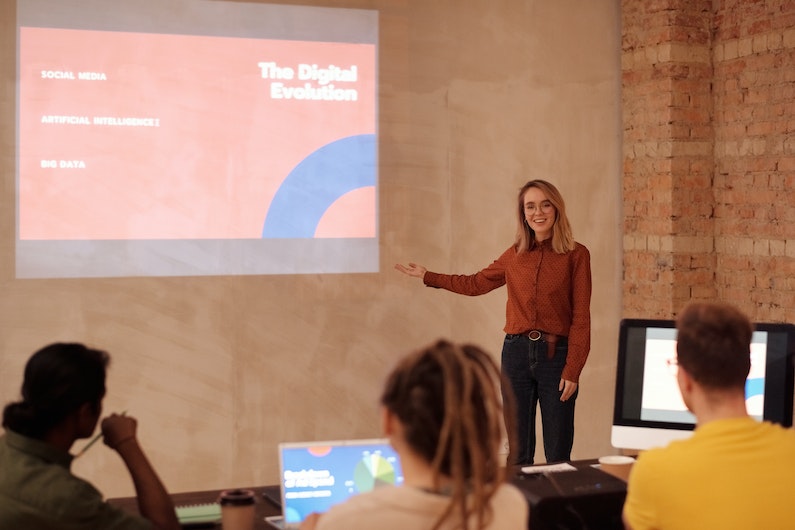You’ve got a lot to say, but limited time and an audience with an even more limited attention span. How can you make your presentation captivating, engaging, and memorable? As with so many things, less is often more.

Presentations start to go wrong when the balance shifts from a shared experience among people, to one person boring everyone else with a relentless slideshow. Quite quickly, the audience becomes disengaged and uninterested. Honestly, you might as well be showing them photographs from your aunt Hilda’s 30-year archive of vacation photos – because they’re not paying attention.
When a customer has made the effort to come to your briefing center, you should reward them with a captivating presentation that speaks to them. Slideshows should be used economically and be supported with personalized digital storytelling that triggers engagement.
Storytelling makes slideshows more effective
Experts recommend that if you are going to use a slideshow in your presentation, to make this a relatively small, supporting role in a bigger and more ambitious production. Presenting isn’t just about information transfer, it’s a performance that gives knowledge significance, by highlighting its meaning and real-world impacts. This is where storytelling (and good digital storytelling software) comes in.
Storytelling can help you to create and execute presentations that are well-structured, personalized, and highly relevant. With the power of storytelling on your side, you’re sure to win that deal or budget increase. And good digital storytelling software can make the greatest difference by helping you integrate your digital storytelling, slideshows, media assets, graphs and data into a single cohesive presentation packed with persuasion.

6 PowerPoint Tips for better presentations
Let’s start with that tricky slideshow. Too often, nervous presenters will pack their PowerPoint (or other slideshow) with all the facts they need to make sure they have them handy, and that nothing is left out. The problem is that the audience will feel that they ought to be reading everything, leaving them distracted and distressed when they can’t keep up with the pace or read the text. The last thing you want is for the audience to feel left out of your presentation, as this is the first step to total disengagement and boredom. This leads to our first tip.
#1: Make it Personal
A generic presentation has limited impact. When speaking to specific or segmented audiences, you need to address pain points and challenges that are directly relevant to them. They need a personal story that they can relate to.
#2: Speak to the audience – not at them
You should aim to structure your presentation to encourage both participation and interaction. These two distinct facets are often confused with one another, but are very different. Participation simply means getting the audience to take some role in moving the presentations, by answering or asking questions for example.
Participation can boast engagement, but it’s not as powerful as interaction. Interaction is different from participation, because it enables the audience to change the course of the presentation. If used well this can create a deeply personalized experience, but it requires a high level of technical capability. To properly make your presentation interactive it needs the ability to become nonlinear – which is something slideshow apps cannot easily do. Non-linear storytelling relies on the ability to serve any piece of content at any time; you need digital storytelling software to do this.
#3: Use emotion to trigger action
People use logic to justify their decisions, but the decision-making process itself has a strong emotional component. This is often called ‘gut feeling’, and it’s a reflection of a sense of trust and belief, combined with an emotive trigger that supports the ‘why’ behind the decision. To make your presentation persuasive, you should use your digital storytelling software to serve relevant digital stories that your audience can really relate to. These will have the greatest emotional impact and drive more confident decision making.
#4: The 3 S’s: Structure, Story, and Self
To support your storytelling-powered presentation, it needs to have a solid foundation. These are called the 3 S’s and they date back to the ancient Greeks, who were renowned orators and rhetoricians. First, your presentation should include a clear structure, so the audience can plot their path on this journey. You can start out with an overview of topics for example, and tell them what the point of the presentation is. If you can give them a role in this, it will help keep them focused.
Next, you need to use a story that makes your points relatable. This helps to illustrate how numbers in a spreadsheet affect real-world situations for actual people, or why your presentation matters.
And, finally, it’s you: Self. The audience needs to know who you are, and why you’re worth listening to. In some cases, your job title may seem self-explanatory in this respect, but people need a little more. Explain why you are in this role, why it matters, and why you’re qualified to talk about this subject.
#5: The 5-5-5 Rule
Keep your slideshow light, with a minimum of text on the slides themselves. If you are piling details into the slides, then the audience will have their attention divided. Use a maximum of 5 words per line, 5 lines of text on any one page, and no more than 5 consecutive, text-heavy slides. These are maximum values – it’s better to use less.
#6: The 10-20-30 Rule
Guy Kawasaki, a previous chief evangelist for Apple, came up with the 10-20-30 rule to make presentations more bearable for everyone. It recognizes that attention span is limited, and that we want to listen to people, not read endless slides. The 10-20-30 rule states that your presentation should include no more than 10 slides, should last no more than 20 minutes, and font size should be no smaller than size 30.

Digital storytelling software: The final word on presentations
Our technology is evolving fast, and we can expect presentations to change a lot in the coming years. The rules and tips above all recognize that attention spans are shrinking, and that we need a human connection to get the most out of information. Digital storytelling software will continue to play a growing role in presentations, as this allows a richer experience that can accommodate true interaction and digital storytelling. In combination with a great structure, a presentation that uses digital storytelling software to connect with audiences on a personal level will be more impactful than anything else you can achieve with a simple slideshow.
Another huge benefit of using modern digital storytelling software is the fact that it can reduce the redundancy of preparation before presentations. By using a shared media asset library, you can easily pull together a personalized presentation that can always use the most up-to-date figures and data.

